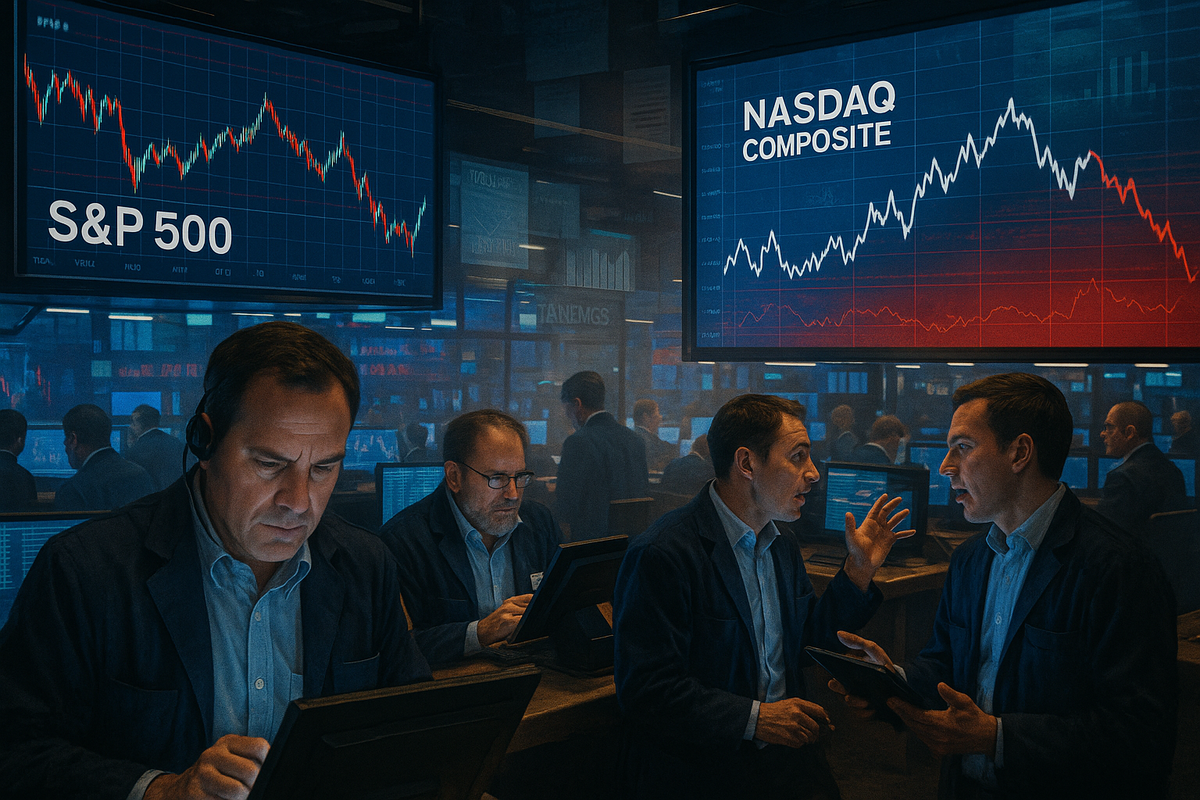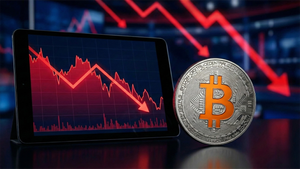
The United States stock market is currently a landscape of intriguing contrasts, with major indices exhibiting both robust performance and underlying volatility. The S&P 500 Index (SPX) is once again knocking on the door of a new record high, while the Nasdaq Composite (IXIC) has recently achieved multiple all-time closing highs. This upward momentum, however, is tempered by persistent concerns over evolving tariff policies and the ongoing scrutiny of corporate earnings reports, creating a complex environment for investors.
This period of mixed signals underscores a market grappling with both fundamental strengths and geopolitical uncertainties. The resilience shown by the S&P 500 and Nasdaq suggests a degree of investor confidence in corporate profitability and technological innovation, even as broader economic anxieties, particularly those stemming from trade disputes, continue to ripple through various sectors. Understanding these dynamics is crucial for navigating the current financial climate and anticipating future market movements.
A Market in Flux: Tariffs, Earnings, and Record Chases
The current state of the US stock market is characterized by a delicate balance between bullish sentiment, driven by strong corporate earnings, and cautious apprehension, fueled by an unpredictable tariff landscape. As of early August 2025, the S&P 500 stands at 6,380.63 USD, a mere 0.8% shy of its all-time closing high of 6,427.02 USD, achieved on July 31, 2025. The tech-heavy Nasdaq Composite has been particularly buoyant, closing at a new record high of 21,242.70 on August 7, 2025, marking its 17th all-time closing high this year. The Dow Jones Industrial Average (DJIA), while not at its peak, has also shown positive movement, recently up 0.6% on August 8, 2025, though still below its December 2024 record of 45,073.63 USD.
The primary catalyst for recent market volatility has been the US administration's aggressive stance on tariffs. A significant shift occurred on April 2, 2025, dubbed "Liberation Day," when President Trump announced sweeping new tariff policies, including a 10% tariff on all imported goods effective April 5, 2025, and individualized reciprocal higher tariffs from April 9, 2025. This announcement triggered a widespread panic sell-off across global stock markets, marking the largest global market decline since the 2020 COVID-19 crash. On April 3, 2025, the Nasdaq Composite plummeted 1,600 points, the S&P 500 fell by 4.84%, and the Dow dropped 1,679 points (3.98%). The following day, China's retaliatory 34% tariff led to further declines, with the Dow falling an additional 2,231 points (5.5%) and the Nasdaq Composite entering bear market territory.
However, the market demonstrated remarkable resilience. On April 9, 2025, a pause in tariff increases announced by the Trump administration sparked a significant rally, with major US indices posting their largest gains in years. By May 13, 2025, following further trade deal discussions, the S&P 500 had turned positive for the year, recovering from the April crash. This rapid rebound highlights the market's sensitivity to trade policy news and its capacity for swift recovery when perceived threats subside.
Adding to the complexity are ongoing corporate earnings reports. For 2025, S&P 500 earnings estimates remain robust, with second-quarter earnings "crushing" expectations, up 9.1%—the strongest beat rate since 2021. This earnings growth, particularly strong in the communications and technology sectors, has largely surprised to the upside, providing a fundamental underpinning for the market's upward trajectory. Despite this, investor sentiment, as measured by the percentage of bullish investors, was at 34.87% as of August 7, 2025, below the long-term average, indicating a degree of underlying pessimism among individual investors even amidst market gains. This mixed sentiment, coupled with elevated valuations for mega-cap US companies and anxiety about interest rates, continues to contribute to increased stock volatility.
Navigating the Crosscurrents: Potential Winners and Losers
The current market environment, characterized by robust earnings in some sectors and the disruptive force of tariffs, is creating a clear divide between potential winners and losers among public companies.
Leading the charge among the winners are companies within the Technology and Communications sectors, particularly those heavily invested in Artificial Intelligence (AI). The insatiable demand for AI-driven solutions, data center expansion, and algorithmic efficiency is fueling substantial growth. Nvidia (NASDAQ: NVDA), a prime example, reported a staggering 262% increase in revenue and a 628% rise in net income in the first quarter of fiscal year 2025, driven by exploding demand for its offerings. Similarly, Palantir Technologies (NYSE: PLTR), an AI software company, has seen its U.S. commercial business grow significantly, making it a top-performing S&P 500 stock in 2025. Other beneficiaries include SoundHound AI (NASDAQ: SOUN), with a 151% year-over-year revenue surge, and AppLovin (NASDAQ: APP), experiencing explosive revenue growth due to its AI-powered Axon 2 engine. Tech giants like Microsoft (NASDAQ: MSFT) and Alphabet (NASDAQ: GOOGL) are also thriving, benefiting from cloud computing and a rebound in digital ad spending, respectively. The "Magnificent 7" stocks, a group including Nvidia, Apple (NASDAQ: AAPL), Amazon.com (NASDAQ: AMZN), Meta Platforms (NASDAQ: META), Tesla (NASDAQ: TSLA), Broadcom (NASDAQ: AVGO), Microsoft, and Alphabet, collectively contributed 55% of total market gains in 2024, largely due to their strong positions in AI technologies.
Conversely, sectors heavily reliant on global supply chains and imports are bearing the brunt of the new tariff policies. The average US import duty has climbed from approximately 2.3% to around 18.3%, the highest in decades, leading to increased costs, reduced profits, and potentially higher consumer prices. Automakers are particularly vulnerable. Toyota (NYSE: TM) reported a 37% drop in profit in Q2 2025 and cut its full-year earnings forecast due to tariffs. General Motors (NYSE: GM) projects a tariff hit of up to $5 billion for 2025, and Ford (NYSE: F) expects $3 billion in revenue loss. Stellantis (NYSE: STLA) faced approximately $350 million in tariff costs in the first half of the year. These companies are often absorbing costs for now, a strategy that is unsustainable in the long run.
Beyond automotive, other import-heavy industries are feeling the pinch. Sonos (NASDAQ: SONO), a consumer electronics maker, announced it would raise prices on its audio devices due to higher reciprocal tariffs on imports from Vietnam and Malaysia. Retailers like Walmart (NYSE: WMT) have warned that higher tariffs would force them to increase prices on a wide range of items, potentially impacting consumer spending. Even beverage companies like Diageo (NYSE: DEO), the maker of Guinness, anticipate tariffs will cost them $200 million annually. Industrial and manufacturing companies, such as Caterpillar (NYSE: CAT), are also experiencing significant disruptions and negative impacts on production due to tariffs, with Caterpillar warning of up to $1.5 billion in costs in 2025. Small businesses, especially importers, are disproportionately affected, facing competitive disadvantages and employment drops.
In addition to import-reliant sectors, companies sensitive to economic slowdown and volatility are also facing headwinds. While the overall market has shown resilience, sectors like Consumer Discretionary (Durable Goods) are expected to slow down due to higher tariffs and elevated interest rates. Banks, such as JPMorgan Chase (NYSE: JPM), can be negatively impacted by falling bond yields, as their profitability relies on higher interest rates for loans. The current market thus presents a bifurcated landscape, rewarding innovation and strong earnings in certain tech segments while penalizing those caught in the crosshairs of escalating trade tensions.
Industry Impact and Broader Implications
The current state of the US stock market, marked by both record-nearing highs and significant volatility, carries profound implications that extend far beyond daily trading figures. It reflects a broader economic landscape shaped by persistent inflation, evolving monetary policy, and a notable shift towards protectionist trade policies. This dynamic environment is not merely a blip but a significant trend that will reshape industries, influence global partnerships, and test the mettle of regulatory bodies.
One of the most significant broader industry trends is the proliferation of Artificial Intelligence (AI). The early stages of AI's widespread adoption continue to drive tech stocks, and, due to their immense power demands, are also boosting more defensive sectors like telecom and utilities that provide the necessary infrastructure for new data centers. This trend is creating a new wave of investment and innovation, fundamentally altering how businesses operate and compete. Simultaneously, the new US tariffs are accelerating a trend towards supply chain restructuring, emphasizing diversification and "reshoring" of global supply chains. This involves increased investment in domestic manufacturing facilities and a greater emphasis on partnerships with allied nations to reduce reliance on specific markets, particularly China. This shift will lead to increased operational costs for businesses as they invest heavily in risk mitigation and compliance, but it also presents opportunities for domestic industries.
The ripple effects on competitors and partners are substantial. Given the US stock market's position as the world's largest, its movements often set the tone for global stock trends, and any significant shift in the US economy disproportionately impacts other countries. Companies with strong balance sheets and diversified revenue streams are better positioned to weather downturns and potentially gain market share from weaker rivals. Conversely, supply chain partners might experience reduced orders from struggling manufacturers or retailers. The current environment also underscores the growing importance of international partnerships for diversifying supply chains and mitigating reliance on single markets. For instance, domestic steel and aluminum producers, such as Nucor (NYSE: NUE), are poised to benefit from tariffs that make foreign competitors' products more expensive. Conversely, multinational corporations heavily reliant on global supply chains and international trade, like Apple (NASDAQ: AAPL) and Tesla (NASDAQ: TSLA), face significant headwinds due to tariffs, increased costs, and disruptions. In the semiconductor industry, political pressure on companies like Intel (NASDAQ: INTC) could create opportunities for rivals such as Nvidia (NASDAQ: NVDA), and accelerate the "de-risking" of supply chains from China, potentially pressuring companies like Taiwan Semiconductor Manufacturing Company (NYSE: TSM) to expand their US operations.
From a regulatory and policy standpoint, the Federal Reserve faces a delicate balancing act. With inflation proving "stubbornly persistent," the Fed is expected to slow its pace of interest rate cuts, complicating policy decisions and limiting its flexibility to support markets through monetary easing. The Trump administration's implementation of new tariffs, with an average effective rate exceeding 15% (the highest since the late 1930s), represents a significant shift towards a more protectionist and nationalist economic approach. These tariffs create uncertainty for businesses, contribute to inflation, and have led to retaliatory measures from trading partners, disrupting global supply chains and increasing production costs worldwide. The Securities and Exchange Commission (SEC) remains the primary regulator overseeing US capital markets, tasked with maintaining fair, orderly, and efficient markets amidst these complex forces.
Historically, the current market environment, with its blend of high valuations, inflation concerns, and geopolitical tensions, echoes elements of past economic cycles. The discussions around "stagflation," where economic stagnation coexists with rising prices, draw comparisons to historical periods where similar conditions prevailed. The current average effective tariff rate is the highest since the late 1930s, raising concerns about similar economic consequences to those seen during the Great Depression. While the "Magnificent 7" led recent market gains, the broadening participation in 2025 suggests a potential divergence from the extreme concentration seen in some past bubbles, offering a glimmer of hope for a more diversified and stable market, but the underlying uncertainties remain.
What Comes Next
The trajectory of the US stock market in the coming months and years will be shaped by a complex interplay of economic fundamentals, geopolitical developments, and policy decisions. While the market has shown remarkable resilience, particularly with the S&P 500 nearing record highs, investors should brace for increased volatility and a more nuanced landscape.
In the short term, the market is likely to remain sensitive to news regarding tariff negotiations and the Federal Reserve's monetary policy. Expectations of a Fed rate cut in September have provided a recent boost, with some analysts, like Goldman Sachs, projecting further rallies for the S&P 500. However, warnings about stretched valuations, especially in high-flying tech names, suggest a potential near-term deterioration. August, historically a month of lower trading volumes and increased market swings, could see a modest pullback. The slowing rate of US economic growth, with some economists not foreseeing a reacceleration until early 2026, also adds a layer of caution to the immediate outlook.
Looking at the long term, the US economy is generally expected to avoid a recession, though GDP growth is forecast to be modest in 2025, with potential improvement in 2026 if trade and tariff uncertainty recedes. The resilient outlook for earnings growth in 2026 and the prospect of continued interest rate cuts support the possibility of the market continuing to climb. Experts anticipate that the Federal Reserve will cut interest rates before year-end 2025, laying the groundwork for a cyclical recovery. This suggests that despite potential short-term turbulence, the underlying positive economic momentum is expected to continue, supported by a healthy consumer and resilient labor market.
For companies, strategic pivots and adaptations will be crucial. Navigating the complexities of tariffs and supply chains will remain a top priority. Companies will need to consider re-routing goods, increasing domestic manufacturing, or even establishing additional foreign manufacturing in countries less impacted by tariffs. Continued investment in technological innovation, particularly in AI and cloud computing, will be paramount for reducing costs ("digital deflation"), streamlining operations, and meeting evolving consumer demand. Adopting agile business strategies, which involve recalibrating goals based on market changes, will be essential for creating stability in an uncertain environment. Furthermore, market diversification and localization, especially for foreign companies entering the US market, will be vital for success.
Market opportunities will emerge in sectors aligned with broader economic trends, such as technology (especially AI and cloud computing), renewable energy, and financial services. While growth stocks have dominated, value stocks and small-cap companies, currently trading at a discount, could present attractive opportunities as the market broadens. The resilient consumer and strong corporate profits will continue to underpin the market's expansion. However, challenges abound. Ongoing trade and tariff negotiations pose a pressing near-term risk, potentially increasing inflation and weighing on economic growth. The specter of "stagflation," where persistent higher import costs combine with slowing economic growth, remains a concern. Stretched valuations in certain segments of the market also offer no significant margin of safety against macro risks. The mercurial nature of tariff policymaking and ongoing trade negotiations will likely continue to create sector churn and make broad sector recommendations difficult.
Several potential scenarios could unfold. A continued bullish trend with moderated gains is plausible, supported by Fed rate cuts and resilient earnings, though the pace of gains may cool. A short-term pullback or correction is also possible, driven by stretched valuations or weak economic data. A stagflationary environment could emerge if tariffs lead to persistent higher inflation and slower growth, putting downward pressure on stock prices. Finally, increased volatility due to policy uncertainty will likely be a constant, as political rhetoric and unexpected policy shifts continue to influence market sentiment. Ultimately, while the US stock market has demonstrated strength and is expected to continue its expansion, investors should be prepared for increased volatility and more modest gains. The impact of tariffs on inflation and economic growth, the timing and extent of Fed rate cuts, and the ability of companies to adapt to changing market dynamics will be crucial determinants of the market's trajectory.
Conclusion
The US stock market currently presents a fascinating paradox: a landscape where major indices flirt with record highs even as underlying currents of volatility and uncertainty persist. The S&P 500's proximity to its all-time peak and the Nasdaq's recent string of record closes underscore the market's resilience and the robust performance of key sectors, particularly technology and communications, fueled by the burgeoning AI revolution. However, this upward momentum is continuously challenged by the unpredictable nature of tariff policies and the ongoing scrutiny of corporate earnings.
The key takeaway from this period is the market's remarkable ability to absorb and rebound from significant shocks, as evidenced by its swift recovery from the "Liberation Day" tariff-induced sell-off in April 2025. This resilience is largely attributed to strong corporate earnings, particularly in the tech sector, and the anticipation of favorable monetary policy from the Federal Reserve. Yet, the pervasive impact of tariffs on import-heavy industries, such as automotive and consumer electronics, highlights a clear bifurcation in market performance, creating distinct winners and losers.
Moving forward, investors should anticipate a market characterized by continued volatility and more modest gains compared to recent periods of rapid ascent. The interplay between inflation, interest rate decisions by the Federal Reserve, and the evolving landscape of global trade policies will be paramount. Companies will need to prioritize agile business strategies, supply chain diversification, and continued investment in technological innovation to navigate these complexities. The potential for "stagflation" remains a concern, and the market's sensitivity to policy shifts will likely keep investors on edge.
In the coming months, investors should closely watch for further developments in trade negotiations, particularly regarding the scope and duration of tariffs. The Federal Reserve's signals on interest rate adjustments will also be critical, as will the ongoing flow of corporate earnings reports, which will provide crucial insights into the health of various sectors. While the US stock market has demonstrated its capacity for growth amidst challenges, a discerning and adaptive approach will be essential for investors seeking to capitalize on opportunities and mitigate risks in this dynamic environment. The current period serves as a powerful reminder that even in times of apparent strength, vigilance and a deep understanding of underlying economic forces are indispensable.






